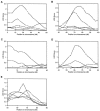Comparison of genome screens for two independent cohorts provides replication of suggestive linkage of bone mineral density to 3p21 and 1p36
- PMID: 12478480
- PMCID: PMC378619
- DOI: 10.1086/345819
Comparison of genome screens for two independent cohorts provides replication of suggestive linkage of bone mineral density to 3p21 and 1p36
Abstract
Low bone mineral density (BMD) is a major risk factor for osteoporotic fracture. Studies of BMD in families and twins have shown that this trait is under strong genetic control. To identify regions of the genome that contain quantitative trait loci (QTL) for BMD, we performed independent genomewide screens, using two complementary study designs. We analyzed unselected nonidentical twin pairs (1,094 pedigrees) and highly selected, extremely discordant or concordant (EDAC) sib pairs (254 pedigrees). Nonparametric multipoint linkage (NPL) analyses were undertaken for lumbar spine and total-hip BMD in both cohorts and for whole-body BMD in the unselected twin pairs. The maximum evidence of linkage in the unselected twins (spine BMD, LOD 2.7) and the EDAC pedigrees (spine BMD, LOD 2.1) was observed at chromosome 3p21 (76 cM and 69 cM, respectively). These combined data indicate the presence, in this region, of a gene that regulates BMD. Furthermore, evidence of linkage in the twin cohort (whole-body BMD; LOD 2.4) at chromosome 1p36 (17 cM) supports previous findings of suggestive linkage to BMD in the region. Weaker evidence of linkage (LOD 1.0-2.3) in either cohort, but not both, indicates the locality of additional QTLs. These studies validate the use, in linkage analysis, of large cohorts of unselected twins phenotyped for multiple traits, and they highlight the importance of conducting genome scans in replicate populations as a prelude to positional cloning and gene discovery.
Figures



References
Electronic-Database Information
-
- Center for Medical Genetics, Marshfield Medical Research Foundation http://research.marshfieldclinic.org/genetics/ (for marker order and genetic distance between markers)
-
- Généthon, http://www.cephb.fr/bio/ceph-genethon-map.html (for marker order and genetic distance between markers)
-
- National Center for Biotechnology Information, http://www.ncbi.nlm.nih.gov/ (for identification of candidate genes in loci of interest)
-
- UCSC Genome Bioinformatics, http://genome.cse.ucsc.edu/ (for marker order and genetic distance between markers)
References
-
- Albagha OM, Tasker PN, McGuigan FE, Reid DM, Ralston SH (2002) Linkage disequilibrium between polymorphisms in the human TNFRSF1B gene and their association with bone mass in perimenopausal women. Hum Mol Genet 11:2289–2295 - PubMed
-
- Andrew T, Hart DJ, Snieder H, de Lange M, Spector TD, MacGregor AJ (2001) Are twins and singletons comparable? A study of disease-related and lifestyle characteristics in adult women. Twin Res 4:464–477 - PubMed
-
- Devoto M, Shimoya K, Caminis J, Ott J, Tenenhouse A, Whyte MP, Sereda L, Hall S, Considine E, Williams CJ, Tromp G, Kuivaniemi H, Ala-Kokko L, Prockop DJ, Spotila LD (1998) First-stage autosomal genome screen in extended pedigrees suggests genes predisposing to low bone mineral density on chromosomes 1p, 2p and 4q. Eur J Hum Genet 6:151–157 - PubMed
Publication types
MeSH terms
LinkOut - more resources
Full Text Sources
Other Literature Sources
Medical

